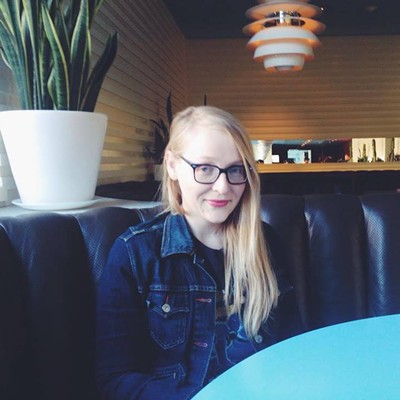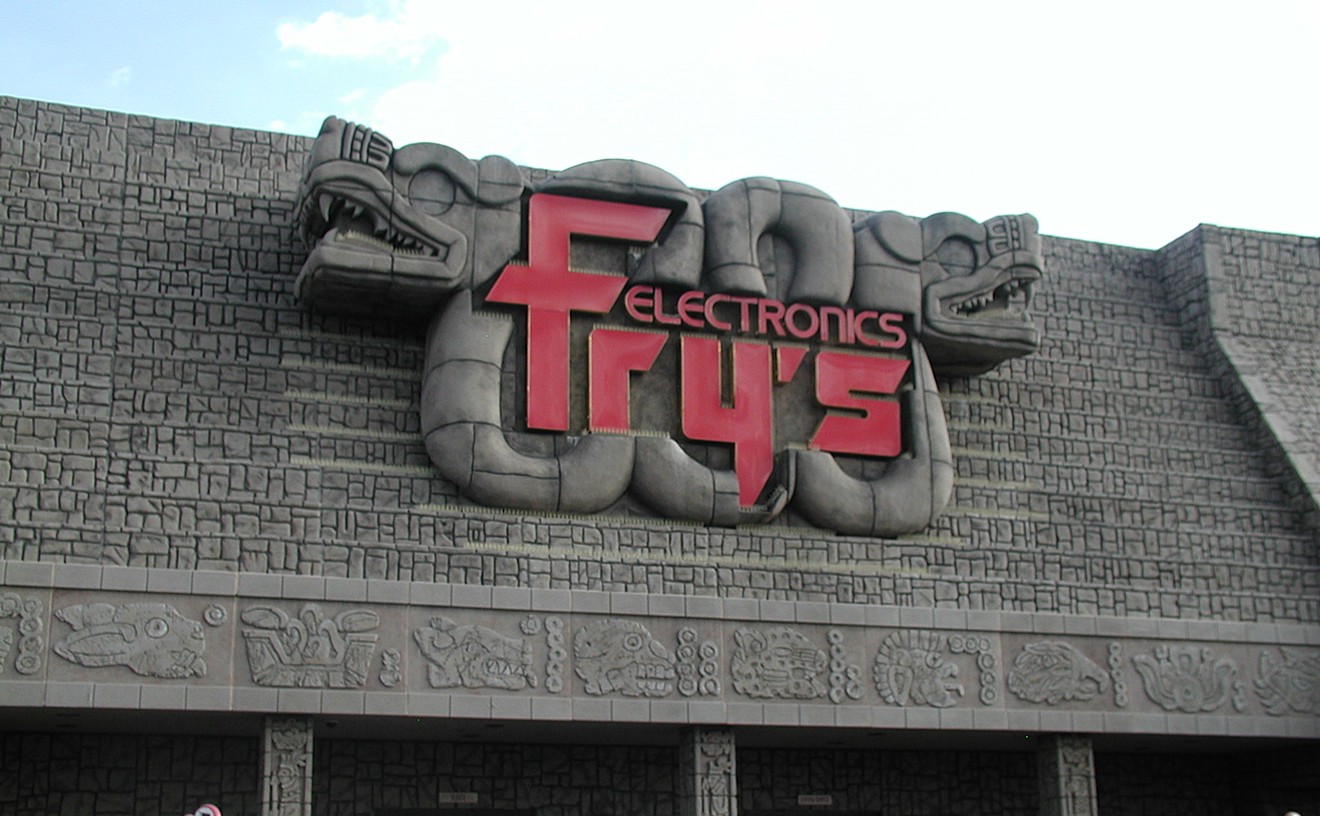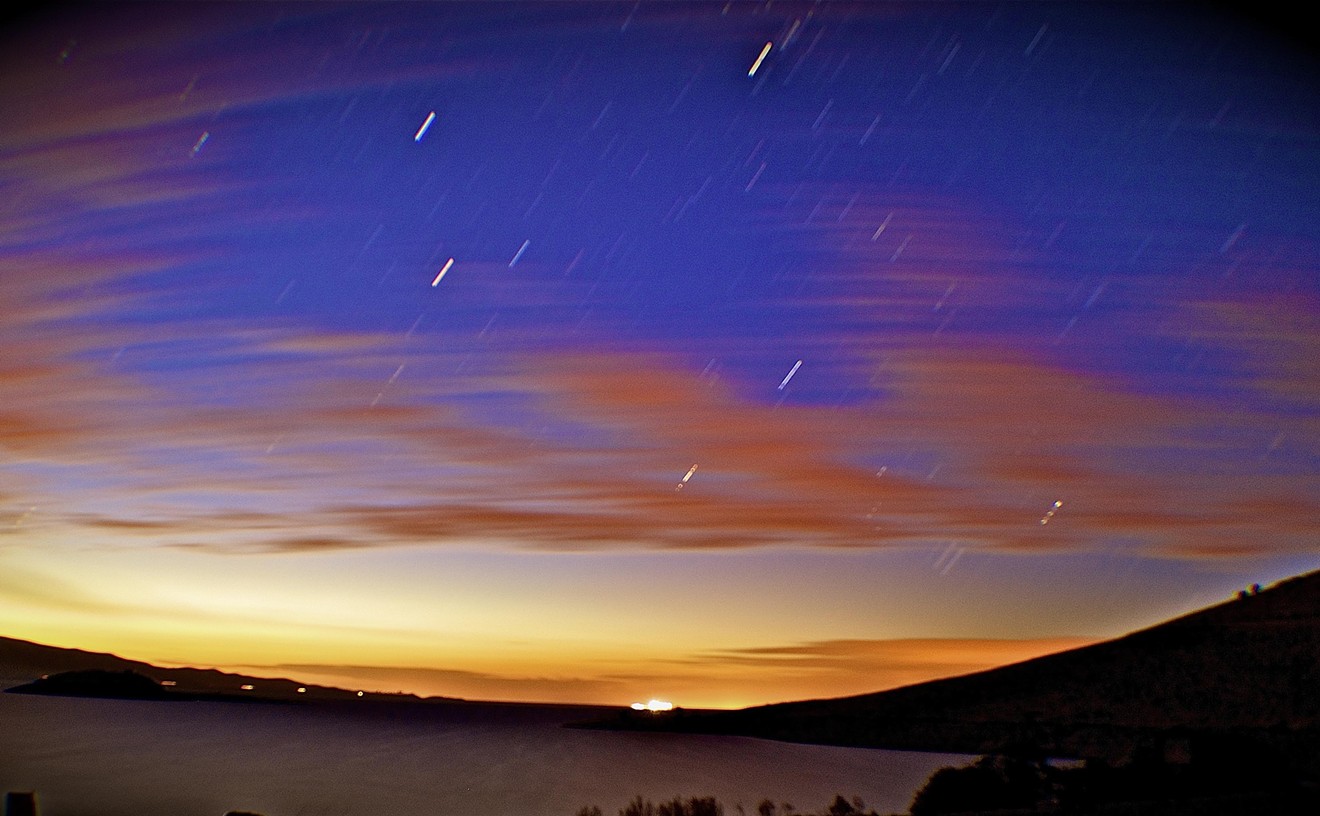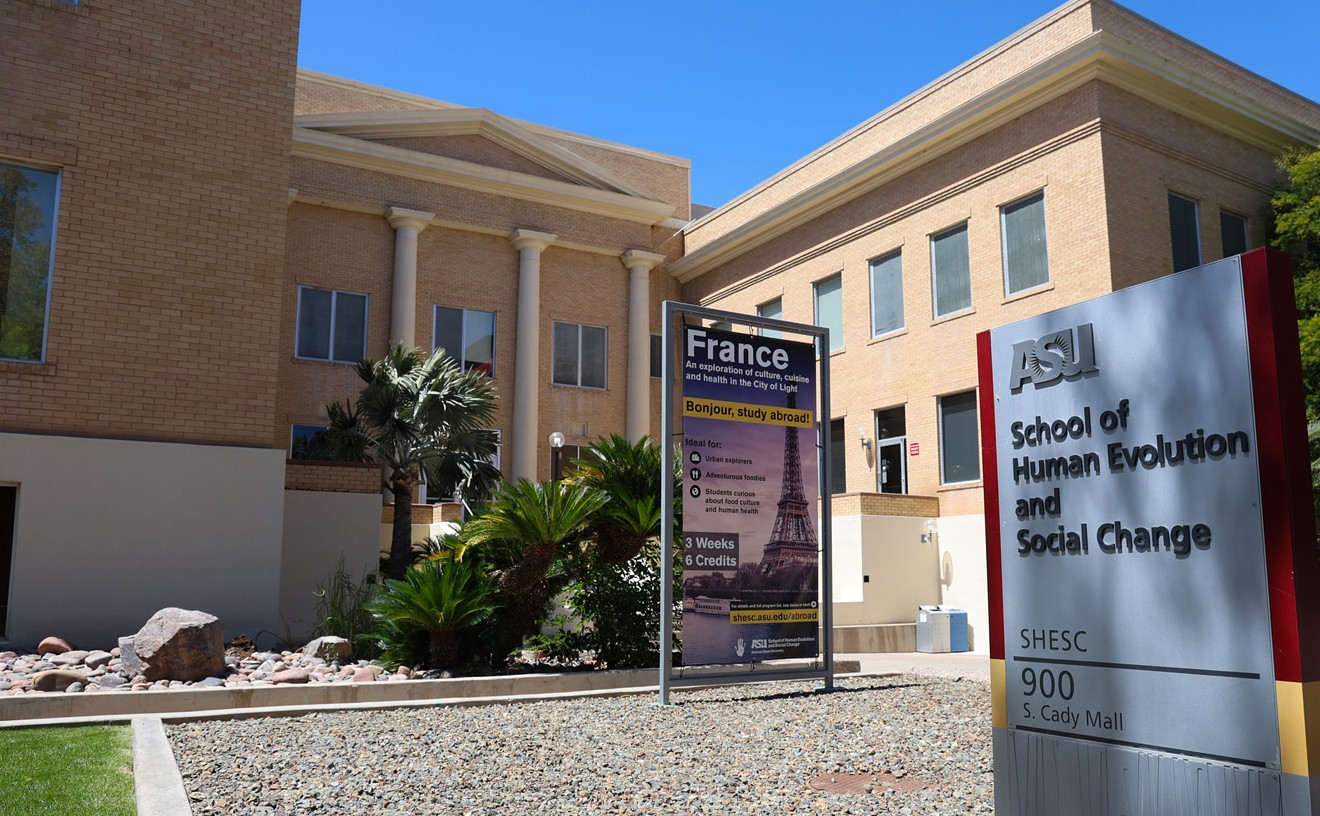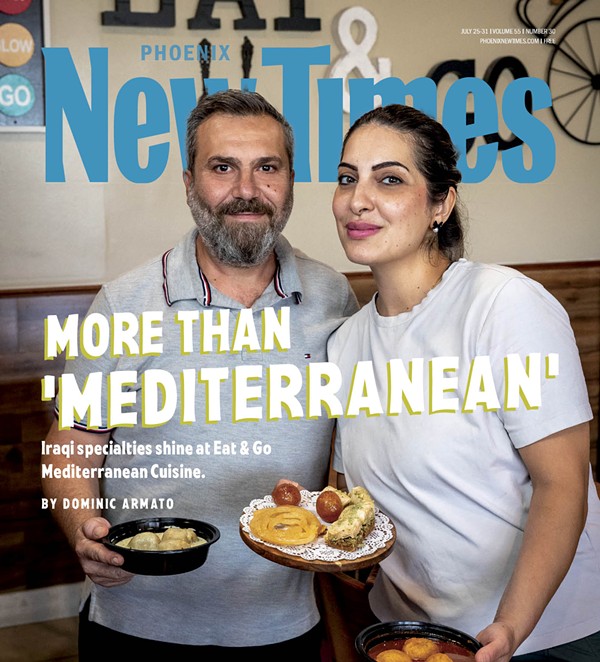Agnese Udinotti has seen it all.
On a cold, cloudy January morning, her small frame is wrapped in layers of black, her dark hair tied back. She's wearing shaggy, nearly knee-high Ugg boots. Taking a seat on an armless chair covered with a deep red throw in the front room of her eponymous downtown Scottsdale gallery, the septuagenarian makes it clear that she's not optimistic when considering the vibrant scene that used to surround this spot.
"The facts are totally political," she says.
Light from the large front windows fills the art space, which looks out on Marshall Way, a stretch that was once a beacon of contemporary art in Arizona. The artist has owned and operated Udinotti Gallery in Scottsdale since 1964, originally operating out of an old barn and then moving to this particular space when she bought it in 1971.
Udinotti jokingly refers to herself as the "old queen" of the arts district. Given how many gallerists have come and gone during her career in the Phoenix suburb, she's not wrong. To her, the topic of art is dead serious — it's sacred — and her passion for it is what has kept her here. She represents a stable of artists whose works line the gallery's whitewashed block walls, along with her own haunting works of expressionistic figurative art. Ghostly human shapes meet and separate on canvases of reds and browns.
Through a strong European accent that's hard to place (she was born in Greece), Udinotti never minces words, maintaining the kind of intense eye contact that makes you forget she wears silver-rimmed glasses.
Scottsdale was the ultimate destination for art and architecture in the 1970s and into the early '80s, she says, thanks to creative powerhouses including Frank Lloyd Wright and Paolo Soleri and the vast open desert just north of Lincoln Drive. It was a place for imagination and innovation. Commerce followed.
The city's galleries flourished in those years, and Scottsdale's arts institutions built strong national reputations.
After decades of development, not only here but across the Valley, the landscape has completely changed.
"Instead of a city of arts and culture, we are a city of entertainment," Udinotti says. "It's a party city now."
But Scottsdale's arts scene has ebbed and flowed in the past. There's a chance at another comeback, right?
She's cutting with her opinion.
"It doesn't come back."
Scottsdale was once Arizona's premier arts destination. At its peak, the city's downtown district bustled with more than 125 galleries along Main Street and Marshall Way, as well as a talented local artist community and avid collectors. Scottsdale's Thursday night art walk was unparalleled in quality and attendance. To be sure, there was always a kitsch factor, with galleries and gift shops pandering to tourists looking for cheesy Kokopelli tchotchkes and howling coyotes. But some of the best contemporary art of the Southwest was there, too.
Thanks to artistry and vision from creative gallerists including Agnese Udinotti, Elaine Horwitch, and Lisa Sette, Scottsdale became a world-class city for art, where contemporary Southwestern style was redefined and refined, beginning in the early 1960s and continuing until recently.
Certainly the arts district went through boom times and tumultuous periods; the 1980s saw too many people getting into the art business, only to close up shop during the early '90s international art market crash. In 2010, pop-up galleries filled in vacant storefronts, briefly infusing the area with fresh, creative energy.
Then Bentley Calverley and Lisa Sette left Scottsdale for Phoenix, where cheaper rent and larger spaces were up for grabs. The gallerists' departures in October 2012 and April 2014, respectively, sounded to many like a death knell for the suburb's high-end creative scene.
Today, Scottsdale has pretty much lost what was left of its art scene's cool. As the city's remaining galleries try desperately to push toward a revival despite their lackluster inventory and aging audience, the city of Scottsdale's arts institutions face turmoil under the supervision of the Scottsdale Cultural Council, a nonprofit contracted by the city and paid $4 million a year to manage Scottsdale Museum of Contemporary Art, Scottsdale Public Art, and Scottsdale Center for the Performing Arts.
An array of factors contributed to the downfall. High rent forced galleries to shutter or move. Instead of coping with vacancies, the city allowed Old Town to morph into a nightlife destination for dining and drinking.
Now, the Scottsdale Gallery Association lists just 33 galleries on its website. By comparison, Scottsdale's tourism website (experiencescottsdale.com) lists 100 nightclubs, bars, and restaurants.
Worse yet, the crown jewel of the Scottsdale art scene — the city's performing arts center — has lost its shine and its footing as one of the best places to see a live show in metropolitan Phoenix. Its current season features ASU concerts, concurrent productions of different versions of Patti Hannon's Late Night Catechism, and an evening with Candid Camera host Peter Funt.
Which is why it's not so surprising that arts districts and city-funded facilities throughout the Valley are giving Scottsdale a run for its money.
Downtown Phoenix is the obvious successor when it comes to gallery walks, and today it seems just about every Phoenix suburb has an arts facility — in many cases a nicer, more innovative one. Mesa Arts Center, Tempe Center for the Arts, and Peoria Center for the Performing Arts spring to mind first.
Then, there's the infighting. In 2015, some downtown Scottsdale brick-and-mortar establishments rallied against a Thursday night Artisan Market, an event that they saw as drawing away potential art buyers. Their efforts paid off, and the city shut down the Thursday event at Scottsdale Waterfront.
But more foot traffic isn't necessarily the solution when the art world is going digital. Acknowledging this new reality, Calverley recently downsized her warehouse district space. "Art collectors today expect galleries to have a robust online presence as more and more sales are moving to the Internet," she said in a June 2015 announcement, adding that "online trade is expected to more than double by 2018."
Besides the galleries, the Cultural Council has been a mess for years.
Its reputation has solidified as an opaque, powerful entity whose inner workings are spoken of only in whispers. Directors have come and gone, and the latest, Neale (pronounced nee-lee) Perl, who arrived in August 2014, was the topic of rumors last summer when word spread that he planned to restructure how the Scottsdale art institutions operated.
Soon after, SMoCA director Tim Rodgers resigned and beloved performing arts center director Cory Baker left her job. Scottsdale Public Art's Donna Isaac is the sole director to remain in her position. Public Art is also the only organization under the council that receives outside funding. (Per a city ordinance, 1 percent of the budget for every capital improvement project — for example, the construction of a city building or park — is to be spent on acquiring and commissioning public art works.)
Despite the art scene's challenges, Scottsdale's still a popular place to visit — just not for the reasons it used to be.
Stephanie Pressler of the Scottsdale Convention & Visitors Bureau says restaurants have become a major draw. A recent study commissioned by the city showed that shopping and fine dining were the top two activities visitors sought. Galleries, theaters, and museums made the short list of priorities. But they were less popular options than visiting nightclubs, casino outings, and swimming.
Former New Times art critic Kathleen Vanesian has followed the ups and downs of Scottsdale for about 25 years. And this, she says, is as down as she's ever seen it.
"It's just completely dead."
The petunia-lined sidewalks of Scottsdale's arts district are marked with blue and green squares painted onto the concrete along with the message "Art Walk the Line," marking the path to galleries throughout the area.
On a recent Thursday evening, music from well-spaced street performers lilts through the quiet arts district, bounded by Fifth Avenue and First Street between 69th Street and Brown Avenue. People travel in small packs. They pause at lit gallery windows and walk by taped-up "for rent" signs.
There are large-scale works depicting Old Hollywood royalty, landscapes with bright flowers, and bronze broncos. Marilyn Monroe smiles through a glass window. If you're looking for art that provokes and excites, the Thursday night art walk is quite the letdown.
But there are a couple of exceptions on this January night. The crowd buzzes at Gebert Contemporary on Main Street, where the opening of a show from Tempe-based artist John Randall Nelson is a party reminiscent of Scottsdale's glory days, with lively discussion, plenty of wine, and what looks like a genuine interest in the display of the acclaimed artist's recent and older works.
Nelson's collages and sculptures channel wit through layers of paint and cartoonish characters. In one work, a stripe of electric blue tops red ink typography below the simple figure of a bird whose wing (or tail — or something) stretches to four feathers.
Later in a phone interview with New Times, Nelson considers why the gallery scene has quieted so dramatically since he arrived in the Valley in the 1980s. "I think it's just because of the quality of the work at the galleries that are still there," Nelson says, noting Gebert, which represents his work, as an exception.
He says Gebert has been hugely supportive over the 15 years the gallery has repped him, and although art fairs and the online space are where many of the biggest art sales are made these days, he still loves showing his work in a lively atmosphere.
Creating "a body of work and showing it has always been really important to me," he says.
By contrast, that doesn't seem to be the objective of the other galleries and artists around Scottsdale.
"A lot of those galleries are still showing the work they were in 1985," Nelson says. "It tends to be regional. It tends to be flowers and cowboys. I guess there'll probably always be a place for that. Some of the work is beautifully executed, but it just doesn't relate to today."
Galleries like Gebert were once the rule — not the exception.
"It was a cultural exchange that was very much alive," Agnese Udinotti says of the Scottsdale art scene's heyday. "You could not find a parking spot here if you were the son of the mayor."
There was an innate draw, she says. People came to Scottsdale for art because "Scottsdale" meant something. It was highbrow, exciting. It mattered.
When she opened her own gallery of figurative art work, Udinotti relished the discussion that came with Thursday art walks, the excitement of the people who came to see art at places including The Hand and the Spirit, as well as Sette and Calverley's galleries.
She looks back on those days fondly: "No matter where you were in the Valley, you'd come to Scottsdale."
Julie Sasse remembers, too. She worked in the Scottsdale scene from about 1977 to 1994 and was administrative director for Elaine Horwitch's galleries. Sasse's working on a book about Horwitch and thinking about her impact on the arts in Scottsdale — and what's happened since the gallerist's unexpected death from a heart attack in 1991.
Horwitch owned a gallery in Scottsdale and another in Santa Fe (and shorter-lived galleries in Sedona and Palm Springs). Her name was synonymous with color and excitement in Southwest art. And when she died, it was dubbed the end of an era on Marshall Way. Horwitch paved the way in the early '60s for contemporary art in Scottsdale, where cowboy art had reigned supreme.
This was back when Bentley Calverley was an upstart, and Lisa Sette, having presented shows since the mid-'80s, had earned a reputation in the arts community.
"There was an interconnectedness between the galleries and clubs," Sasse says. "It was like a mini-Paris, quite frankly. People kept talking about art over a drink later. In the early days, it was Trader Vic's."
(Sasse's not referring to the short-lived Trader Vic's reboot at the Hotel Valley Ho, but the original Trader Vic's in the space now occupied by Citizen Public House — a stylish spot, but not one connected to the art scene.)
Besides commerce, interaction was the whole point. It wasn't the wine-and-cookies free-for-all that Udinotti says comes with modern-day art walks, which she stopped participating in about three years ago. She describes the typical Scottsdale gallery of today as selling "decorative nonsense for tourists."
But Udinotti has no interest in entertaining tourists who don't take art seriously.
"I might sounds like an elitist, but I am in the art business," Udinotti says. "I don't sell hot dogs."
"Scottsdale grew up around the arts," Sam Campana says.
She should know.
Campana's résumé is impressive. She served as a city council member from 1986 to 1994 and Scottsdale mayor from 1996 to 2000. The contemporary art collector and prominent arts advocate was executive director of Arizonans for Cultural Development and served on the boards of the Scottsdale Arts Center Association and Scottsdale Public Art.
Scottsdale's public art program already had roots in the early 1970s, Campana recalls, and the city's art festival was a big draw.
But the true mark of the city's commitment to creativity came with the Scottsdale Center for the Arts in 1975. Campana describes its opening as "a gutsy statement for a small community."
She's right. At the time, the Valley's only other arts facilities were Gammage Auditorium, which opened in Tempe in 1964, and Phoenix Symphony Hall, which opened downtown in 1972.
Now known as Scottsdale Center for the Performing Arts, the facility presented both performing and visual arts. It wasn't until 1985 that the city established the Scottsdale Cultural Council (originally called the Cultural Council of Scottsdale) as a nonprofit company to manage the Center.
The Center was a hub of creativity. Credit for that is due to Frank Jacobson, the first president and CEO of the Cultural Council, along with visual arts manager John Armstrong and later Robert Knight, the founding director of SMoCA, and Kathy Hotchner, appointed to run the Center in 1988.
"We became known for being innovative and cutting edge," Campana says, adding that "a lot of that had to do with programming, education, and the success of public art."
Scottsdale Public Art commissioned work from James Turrell, including Knight Rise, a skyspace piece that's named for Knight, and Robert Indiana's LOVE sculpture. SMoCA showed Turrell's work. The Center presented the work of Keith Haring in its atrium space.
Hotchner brought cutting-edge performers to town, including Spalding Gray, who would rehearse new works and debut them in Scottsdale, as well as David Sedaris and Wynton Marsalis. Hotchner also commissioned original pieces from performers and troupes including Gray and the Kronos Quartet. (Hotchner did not respond to interview requests from New Times.)
Eventually, the Cultural Council would oversee Scottsdale Public Art, established in 1985, and Scottsdale Museum of Contemporary Art, which opened in 1999.
"He grew all of those programs," Campana says of Jacobson's tenure.
But by 2008, Hotchner, Knight, Armstrong, and Jacobson were gone. Though she didn't specify, in an interview with the Republic from that year, Hotchner alluded to changes at the Cultural Council, on which she served as a vice president, as one of her reasons for leaving.
That was the same year William Banchs stepped into power as Cultural Council president and CEO.
"The only big ripple that I ever saw was the one Bill Banchs made," Campana says. "He never understood the community."
Banchs oversaw the renewal of the council's 20-year contract with the city to manage the arts institutions, eliminated eight full-time positions to cut costs, and quickly developed a reputation for being intimidating.
Talented people exited amid job and budget cuts; insiders saw directors made into scapegoats for larger problems facing the institutions. Tension between Banchs and staffers became so unbearable that multiple board members quit one year, and the next, public art director Valerie Vadala Homer asked for protection as a whistleblower after heated dealings with him.
After 13 years on the job, public art associate director Margaret Bruning left for a job in Los Angeles in 2011. Vadala Homer retired in 2012, capping a 10-year public art directorship during which the institution commissioned more than 200 pieces, both permanent and temporary, including works from James Turrell, Paolo Soleri, and John Randall Nelson. She had put in 25 years with the council.
The troubles didn't end when Banchs left, replaced by Neale Perl. SMoCA director Rodgers and Hotchner's protégé Cory Baker left in 2015. Rodgers' and Baker's respective assistant directors, Sara Cochran and Ally Haynes-Hamblen, stepped into interim directorships and were promoted in January 2016 to the top jobs.
From the outside, it looked like history repeating itself — and, in turn, stomping out progress.
It's a big problem for Scottsdale, where graying locals have become the typical audience members. According to a 2014 study of people who visited Scottsdale, patrons tend to be in their late 50s with a median annual income of $115,000, while the average Scottsdale resident is 44 years old with an annual income of $69,690.
That's where Perl and the Cultural Council come in. They say they want to change the makeup of their audiences by engaging with less affluent and younger arts patrons. Besides doing good in the community, the efforts could affect the council's bottom line by bringing in more donations.
On their to-do list is one major hire: an education director.
Perl cites organizations such as Frances Smith Cohen's Wolf Trap, which brings arts programming to Head Start and other preschool classrooms and organizes field trips for kids to experience theater, as a sterling example of an educational opportunity already in place in Scottsdale.
"I live for these education programs," Perl says.
Besides centralizing educational programming, the council's offices have undergone remodeling to make room for all the organizations to operate out of a central space.
Not everyone's impressed.
"There's all this structural reorganization that really doesn't help any institution to achieve their goals as far as presenting good art to the public," Kathleen Vanesian says. "They're focused on buildings and offices and who reports to whom rather than any emphasis on what's being brought or accomplished in these three very distinct entities."
Indeed, all this movement caused consternation among insiders — because anyone who watched the reign of Banchs and its aftermath knows the effect a Cultural Council president could have.
"It's not just running a museum as if you were running Exxon," Vanesian says of the corporatization of Scottsdale's arts organizations. "Sorry, it's a little more complicated . . . You have to have an aesthetic, an art history background, and your ear to the ground."
The clouds are starting to clear outside Udinotti Gallery as a man and woman dressed in designer jeans and hoodies come through the front door.
They greet the owner politely, but they don't really look at her. "Let me know if you have any questions," she says, knowing they won't. Like zombies with glazed-over eyes, they proceed to walk through the gallery in fewer than five minutes, exiting with a quick "Thanks!" as unceremoniously as they came.
The "looky-loos," as Udinotti calls them, didn't buy anything. Not that she expected them to.
She's learned over the years not to push a looky-loo, and she's also learned that fighting City Hall only gets you so far. After a while, it becomes a useless, tiring exercise, and it never guarantees you'll get what you want.
"My passion is art," Udinotti says, "not the city of Scottsdale."
And that, rather succinctly, is why the longtime gallerist doesn't bother with the politics anymore. She can keep to herself, ignore art walks, close up shop when the city puts on events she deems obnoxious, and still keep doing what she loves.
Julie Sasse says that good galleries moving out could be "just the kick in the pants Scottsdale needs." She thinks a revitalization is possible, especially if SMoCA can act as a beacon in the community under Sara Cochran's leadership.
"It's a matter of whether the city cares," Sasse says of downtown Scottsdale. "SMoCA's a good anchor. Let's build on that. It just needs a little revitalization."
Udinotti disagrees. She says the museum has struggled because its offerings are inconsistent. To succeed in the long run, she says, one must "make a commitment as to what you want to promote." There's no arguing that method has worked for her.
Although she is explicitly not hopeful about the future of the Scottsdale arts scene — galleries, museums, and all, Udinotti does offer that change is inevitable. The only change she swears she wouldn't weather is a bar opening across the street from her gallery on Marshall Way.
But she knows there's not much she can do to keep it from happening.
"At the end of one cycle," she says, "another starts."


